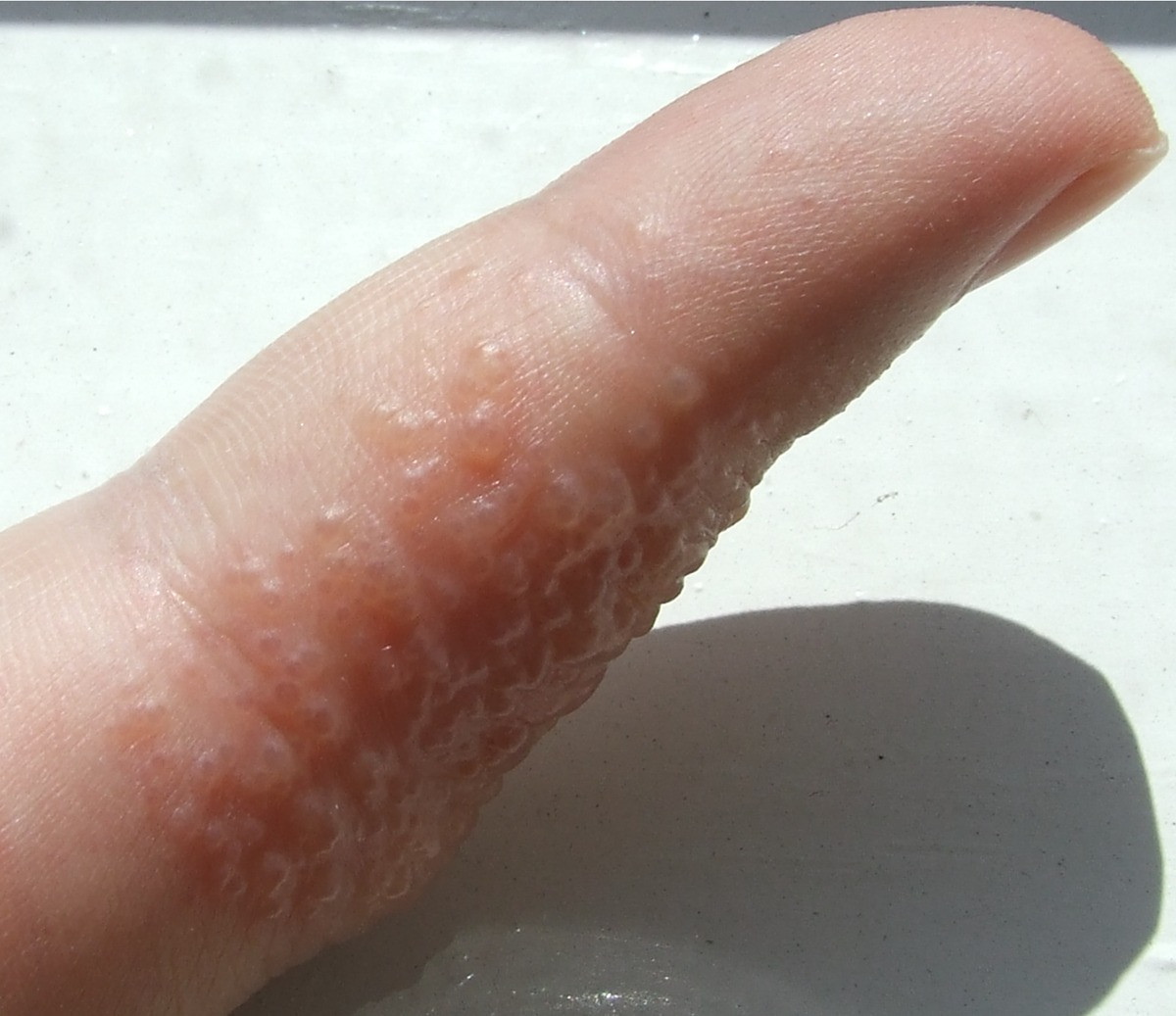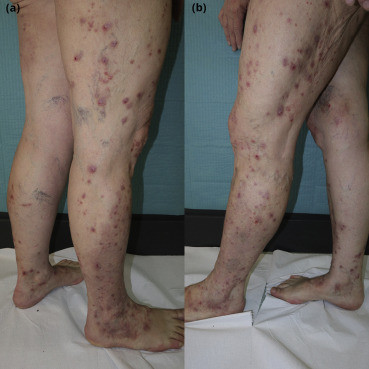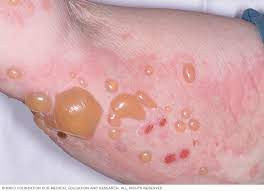Definisi
Dishidrosisadalah masalah kesehatan kulit berupa lenting-lenting kecil atau lepuh berisi cairan yang sering muncul di telapak tangan dan sisi jari. Terkadang dapat juga timbul pada bagian bawah kaki. Dishidrosis yang juga disebut dengan eksim dishidrotik atau pompholyx ini umumnya menetap sekitar tiga sampai empat minggu dan menyebabkan rasa gatal yang hebat.
Setelah lenting mengering, kulit biasanya tampak bersisik atau terkelupas. Dishidrosis terkadang dapat muncul kembali sebelum kulit benar-benar sembuh dari dishidrosis sebelumnya. Penanganan dishidrosis umumnya menggunakan krim atau salep. Pada kasus yang berat, dokter dapat memberikan pil kortikosteroid atau dalam bentuk suntikan.
Penyebab
Penyebab pasti dishidrosis belum diketahui. Kondisi ini dapat dikaitkan dengan kelainan kulit serupa seperti dermatitis atopi (eksim), serta dengan kondisi alergi, seperti urtikaria, yaitu bentol-bentol alergi pada kulit. Dishidrosis diperkirakan berhubungan dengan kasus alergi terkait musim.
Orang dengan dishidrosis umumnya memiliki hipersensitivitas atau terlalu sensitif terhadap beberapa bahan berikut:
- Logam, terutama kobalt dan nikel
- Bahan tertentu pada sabun atau pelembab kulit
- Obat-obatan seperti pil KB atau aspirin
- Rokok
- Infeksi kulit seperti kaki atlet
- Infus immunoglobulin (IVIG) atau antibodi
Stres juga bisa menjadi pemicu dishidrosis, terutama pada perubahan musim. Beberapa orang akan mengalami kekambuhan ketika cuaca panas dan lembab (ketika UVA sangat kuat). Sementara yang lainnya dapat kambuh ketika suhu dingin.
Faktor Risiko
Faktor risiko dishidrosis meliputi:
- Faktor genetik atau keturunan. Jika Anda memiliki anggota keluarga dengan dishidrosis, Anda memiliki risiko dishidrosis lebih besar
- Usia 20-40 tahun
- Stres. Dishidrosis cenderung lebih sering muncul saat kondisi stres
- Paparan logam tertentu, seperti kobalt dan nikel pada lingkungan industri
- Melakukan pekerjaan yang terpapar semen (kemungkinan mengandung kobalt dan nikel)
- Kulit sensitif. Orang yang mudah mengalami ruam setelah kontak dengan iritan atau bahan penyebab iritasi, lebih berisiko mengalami dishidrosis
- Memiliki jenis eksim lain, seperti dermatitis atopik. Beberapa orang dengan dermatitis atopik berisiko mengalami eksim dishidrotik
- Memiliki alergi terkait musim
- Memiliki sakit asma
- Memiliki riwayat sinusitis alergi
Dishidrosis pada anak
Eksim, atau dermatitis atopi, lebih sering terjadi pada anak-anak dan bayi dibandingkan pada orang dewasa. Sekitar 10-20% anak memiliki beberapa jenis eksim lainnya. Namun, sebagian besar akan memiliki dermatitis atopi dan eksim hingga dewasa. Sebaliknya, dishidrosis juga dapat ditemukan pada anak-anak, namun jarang terjadi.
Gejala
Gejala dishidrosis awal biasanya berupa rasa gatal hingga seperti tersengat tanpa ada tampilan apapun di kulit. Kemudian akan muncul lepuh berisi cairan yang bisa muncul di telapak tangan, sela jari, atau kaki. Pada kasus yang berat, lepuh dapat meluas ke daerah tangan, badan, dan kaki.
Pada kasus yang lebih berat, lepuh yang kecil dapat bergabung membentuk lepuh yang lebih besar. Kulit yang terkena dishidrosis bisa terasa nyeri, sangat gatal, dan berwarna kemerahan. Jika terkena infeksi bakteri, lepuh akan terasa nyeri dan bernanah. Dishidrosis cenderung bersifat kambuh-kambuhan dalam hitungan bulan atau tahun.
Umumnya dishidrosis dapat hilang dengan sendirinya pada 3-4 minggu. Namun, ketika lepuh menghilang, kulit biasanya menjadi kering dan terkelupas. Pada orang dengan kulit yang lebih gelap, dapat timbul bercak gelap pada tempat lepuh yang telah sembuh.
Diagnosis
Jika Anda mengalami lepuh, kemerahan, dan gatal pada kulit lebih dari seminggu, Anda perlu berkonsultasi dengan dokter atau dokter kulit karena ada banyak masalah kulit yang dapat menyebabkan lepuh.
Saat pemeriksaan, dokter akan mengamati kulit Anda dan menanyakan apakah ada perubahan pola hidup terkait timbulnya lepuh, seperti apakah Anda menggunakan produk baru yang berbeda dari biasanya, apakah saat ini sedang merasa sangat stres, atau apakah pekerjaan atau hobi yang mengharuskan Anda bersentuhan dengan logam.
Hampir sebagian besar kasus dapat didiagnosis berdasarkan keluhan dan pemeriksaan fisik. Tidak ada tes laboratorium spesifik untuk memastikan diagnosis dishidrosis.
Namun, dokter dapat menyarankan tes untuk menyingkirkan masalah kulit lain yang memiliki gejala serupa. Misalnya, tes kerok kulit untuk memeriksa jenis jamur yang menyebabkan kaki atlet. Alergi dan sensitivitas kulit dapat dinilai dengan tes skin prick, yaitu memaparkan berbagai zat alergen (penyebab alergi) ke kulit untuk mengetahui reaksinya.
Tata Laksana
Pengobatan bergantung pada tingkat keparahan tanda dan gejala yang Anda alami. Pilihan pengobatan meliputi:
- Obat golongan kortikosteroid. Krim dan salep kortikosteroid potensi tinggi dapat membantu mempercepat hilangnya lepuh. Menutup area yang dioles krim dengan plastik bening dapat meningkatkan penyerapan. Kompres lembab juga dapat dilakukan untuk meningkatkan penyerapan obat. Pada kasus yang parah, dokter dapat meresepkan pil kortikosteroid. Namun, penggunaan steroid jangka panjang dapat menyebabkan efek samping yang serius sehingga penggunaannya harus sesuai dengan aturan dokter.
- Fototerapi. Jika perawatan lain tidak efektif, dokter dapat merekomendasikan terapi cahaya khusus yang menggabungkan sinar ultraviolet dengan obat-obatan untuk membuat kulit lebih mudah menyerap terapi cahaya yang diberikan.
- Salep penekan sistem imun. Obat-obatan seperti tacrolimus dan pimecrolimus dapat membantu bagi orang yang ingin membatasi penggunaan steroid. Efek samping dari obat ini adalah peningkatan risiko infeksi kulit.
- Injeksi toksin botulinum. Beberapa dokter mungkin mempertimbangkan suntikan toksin botulinum untuk mengobati kasus dishidrosis yang parah.
Pengobatan rumahan
Pengobatan yang bisa dilakukan di rumah meliputi:
- Mengompres. Kompres dingin dapat membantu mengurangi rasa gatal.
- Mengonsumsi obat antigatal. Obat golongan antihistamin yang dijual bebas seperti diphenhydramine atau loratadine dapat membantu meredakan gatal.
- Pengaturan diet. Nikel dan kobalt adalah elemen alami yang dapat ditemukan pada banyak makanan. Kobalt dapat ditemukan pada kacang brazil, flaxseed, atau buncis. Sedangkan nikel ditemukan pada sereal, teh, atau buah kering. Jika dokter menduga timbulnya dishidrosis akibat alergi nikel atau kobalt, dokter mungkin akan merekomendasikan diet rendah kobalt dan nikel melalui sistem poin. Semakin tinggi jumlah nikel atau kobalt, semakin tinggi nilai poin untuk makanan atau minuman tersebut. Anda akan diminta untuk menghitung poin makanan Anda. Namun, karena ada banyak makanan sehat yang mengandung unsur-unsur alami ini, Anda tidak boleh melakukan diet berbasis poin ini sendiri tanpa pengawasan dokter.
Komplikasi
Komplikasi pada sebagian besar orang dengan dishidrosis mungkin hanya berupa rasa ketidaknyamanan karena gatal. Pada sebagian lainnya, rasa sakit dan gatal dapat membatasi penggunaan tangan atau kaki serta dapat mengganggu tidur. Menggaruk terus menerus karena gatal akan meningkatkan risiko infeksi bakteri pada bagian kulit yang terkena.
Pencegahan
Karena penyebab dishidrosis umumnya tidak diketahui, belum ada cara pasti yang terbukti dapat mencegah kondisi ini. Beberapa cara yang dapat dilakukan untuk mengurangi risiko dishidrosis antara lain dengan mengelola stres dan menghindari paparan logam, seperti kobalt dan nikel. Perawatan kulit yang baik juga akan membantu melindungi kulit. Perawatan kulit tersebut meliputi:
- Menggunakan pembersih yang lembut dan air hangat untuk mencuci tangan, lalu mengeringkannya dengan baik
- Melembabkan kulit secara teratur
- Mengenakan sarung tangan, terutama jika akan terpapar bahan kimia atau bahan yang biasanya menimbulkan alergi
Kapan Harus ke Dokter?
Konsultasi ke dokter jika Anda memiliki ruam, lenting, atau lepuh pada tangan atau kaki yang tidak kunjung hilang dengan sendirinya.
Mau tahu informasi seputar penyakit lainnya? cek di sini, ya!
- dr Ayu Munawaroh, MKK
Dyshidrosis. (2021). Retrieved 14 March 2022, from https://www.mayoclinic.org/diseases-conditions/dyshidrosis/symptoms-causes/syc-20352342
Dock E, DiGiacinto J. (2021). Dyshidrotic (Dyshidrosis) eczema. Retrieved 14 March 2022, from https://www.healthline.com/health/dyshidrotic-eczema
Watson S. (2020). Dyshidrotic eczema. Retrieved 14 March 2022, from https://www.webmd.com/skin-problems-and-treatments/eczema/dyshidrotic-eczema
Pompholyx (dyshidrotic eczema). (2022). Retrieved 14 March 2022, from https://www.nhs.uk/conditions/pompholyx/












